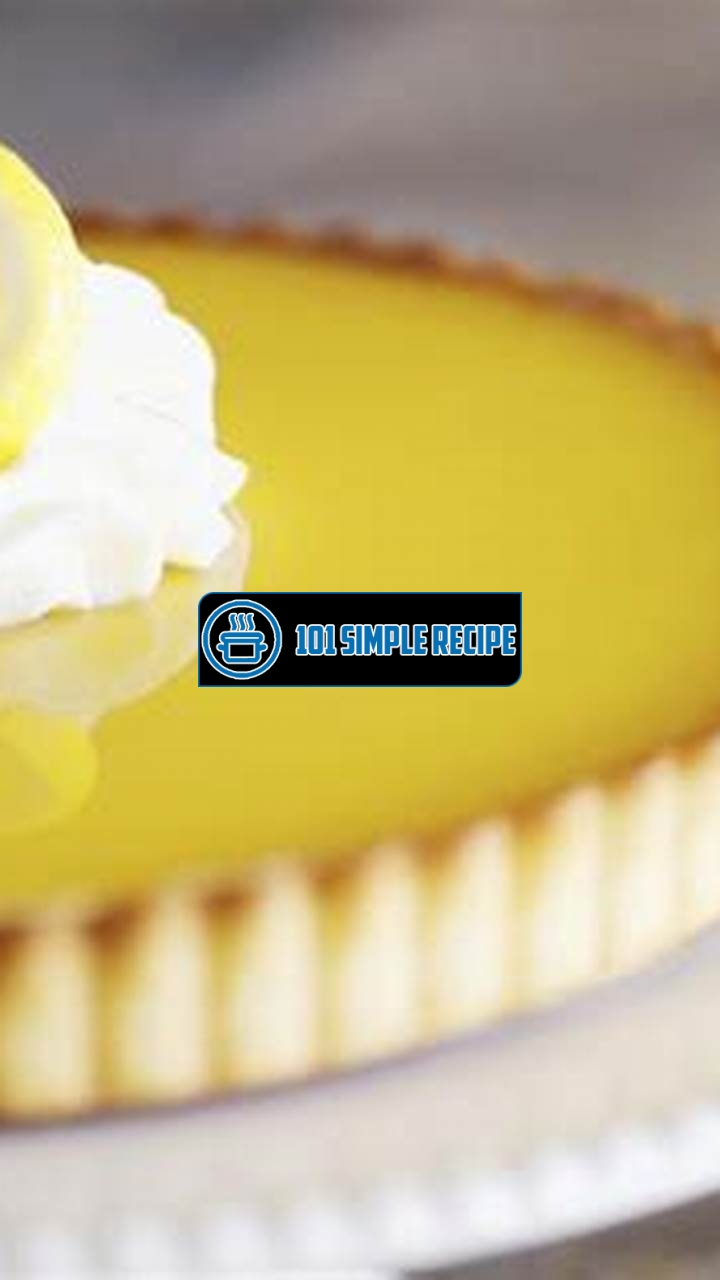Indulge in the divine delights of a French Lemon Tart and transport your taste buds to the charming streets of Paris. This tantalizing dessert, with its delicate pastry crust and tangy lemon filling, is a beloved classic in French patisseries. Bite into the crisp, buttery crust and savor the burst of zesty lemon flavor that follows – it’s a truly heavenly experience. The image below perfectly captures the essence of a French Lemon Tart, inviting you to savor every bite.

History and Origins of French Lemon Tart
Discover the rich history and cultural significance of the French lemon tart.
The Origins of French Lemon Tart
The French lemon tart, also known as tarte au citron, has a long and colorful history dating back to the medieval times. It is believed to have originated in the coastal regions of France, where lemon trees were grown abundantly. The tart was created as a way to showcase the tangy and refreshing flavor of lemons in a delectable dessert.
In the early days, the tart was a simple pastry filled with lemon curd. Over time, bakers started experimenting with different variations, adding meringue toppings or incorporating other fruits such as raspberries or strawberries. However, the classic French lemon tart remains a favorite among dessert lovers.
Legend has it that the recipe for the French lemon tart was passed down from generation to generation, kept as a closely guarded secret by French families. The tart became highly prized and was often served at special occasions and celebrations.
Cultural Significance of French Lemon Tart
The French lemon tart holds a special place in French cuisine and culture. It is considered a symbol of elegance and sophistication, often featured in patisseries and high-end restaurants. The tart is a perfect blend of sweet and tangy flavors, making it a popular dessert choice among locals and tourists alike.
In addition to its culinary significance, the French lemon tart is also a cultural icon. It represents the rich culinary heritage and tradition of the French people. The tart showcases the abundance of fresh ingredients available in the country, with the lemon being a prominent fruit in French cuisine.
The French lemon tart is often associated with summer and sunny days. Its vibrant yellow color and refreshing taste make it a perfect dessert for warm weather. It is often served at picnics, garden parties, and outdoor gatherings, adding a touch of elegance to any occasion.
Traditional Variations of French Lemon Tart
While the classic French lemon tart remains a favorite, there are also various traditional variations that add a unique twist to the dessert. One popular variation is the lemon meringue tart, which features a fluffy meringue topping that adds a light and airy texture to the tart.
Another variation is the lemon raspberry tart, which combines the tartness of lemons with the sweetness of ripe raspberries. This variation provides a delightful burst of flavors and a visually appealing presentation.
Some bakers also experiment with different crusts, using variations such as almond crust or shortbread crust to add depth of flavor to the tart. These variations showcase the creativity and ingenuity of French pastry chefs.
Note: The French lemon tart is a delightful dessert that has a rich history and cultural significance in France. Its origins can be traced back to medieval times, and it has evolved into a symbol of elegance and sophistication. The various traditional variations of the tart add a unique twist to the classic recipe, making it a versatile and beloved dessert among food enthusiasts across the world.
Essential Ingredients for a Perfect French Lemon Tart
Are you ready to indulge in the divine delights of a French lemon tart? This delectable dessert is the epitome of elegance and sophistication, with its tangy lemon filling and buttery tart crust. To create the perfect French lemon tart, it is essential to use the right ingredients that complement each other flawlessly. In this article, we will explore the key ingredients that are necessary to create a delicious French lemon tart.
The Role of Lemons in French Lemon Tart
Lemons play a crucial role in creating the vibrant and refreshing flavor of a French lemon tart. Their tart and citrusy taste adds a delightful tang that balances the sweetness of the tart crust and the richness of the filling. When selecting lemons for your tart, opt for organic ones that are firm and heavy. The zest and juice of fresh lemons will elevate the taste and aroma of your tart, so it’s worth investing in high-quality lemons.
Additionally, it is essential to use the correct amount of lemon juice and zest in your recipe. Too much lemon juice can overpower the tart, while too little can result in a lack of tanginess. It is recommended to use the juice and zest of two to three lemons, depending on their size and your personal preference.
The Importance of a Buttery Tart Crust
A French lemon tart is incomplete without a buttery tart crust that crumbles perfectly with each bite. The tart crust serves as the foundation for the luscious lemon filling and adds a delightful texture contrast. The key to achieving a perfect tart crust lies in using high-quality ingredients and following a foolproof recipe.
Start by using cold butter and cutting it into small cubes. The cold butter will create a flaky texture in the crust. Combine the butter with flour, sugar, and a pinch of salt, and mix until it resembles coarse crumbs. Then, gradually add icy water to bring the dough together. Be careful not to overmix the dough, as it can result in a tough crust. Once the dough is ready, refrigerate it for at least an hour to allow the butter to solidify and the gluten to relax.
When it’s time to roll out the dough, dust your work surface and rolling pin with flour to prevent sticking. Roll the dough out into a circle that is slightly larger than your tart pan. Gently transfer the dough to the pan and press it into the edges, making sure there are no air bubbles. Finally, trim the excess dough and refrigerate the tart shell for another 30 minutes before blind baking it to perfection.
The Sweetness of Sugar in French Lemon Tart
Sugar plays a crucial role in balancing the tartness of the lemons and adding a touch of sweetness to the French lemon tart. The type and amount of sugar you use can greatly affect the overall taste and texture of your tart.
Traditional French lemon tart recipes typically call for granulated sugar, which dissolves easily and evenly throughout the filling. However, you can experiment with different types of sugar to add depth and complexity to your tart. For example, using a combination of granulated sugar and powdered sugar can result in a smoother and silkier filling.
Remember to taste the filling as you go to ensure that the sweetness is just right. You want a harmonious balance between the tartness of the lemons and the sweetness of the sugar. Adjust the sugar according to your preference, but be cautious not to make the tart overly sweet.
In conclusion, to create a truly divine French lemon tart, it is crucial to pay attention to the essential ingredients. The tartness of lemons, the buttery crust, and the perfect amount of sugar all work together to create a harmonious and exquisite dessert. So, gather your ingredients, follow a reliable recipe, and get ready to savor every bite of this heavenly treat.
If you’re looking for more delicious dessert recipes, check out our French lemon tart recipe. It’s a classic dessert that’s sweet, tangy, and perfect for any occasion.
Mastering the Art of Making French Lemon Tart
Step-by-step instructions to help you master the art of creating a French lemon tart from scratch.
Preparing the Tart Crust
Creating the perfect tart crust is essential for a French lemon tart that melts in your mouth with every bite. Here’s how you can prepare the tart crust:
- Gather all the necessary ingredients for the tart crust, such as all-purpose flour, butter, powdered sugar, and salt.
- In a large mixing bowl, combine the flour, powdered sugar, and salt. Stir well to ensure the ingredients are evenly mixed.
- Add cold, cubed butter to the mixture and use your fingertips or a pastry blender to cut the butter into the dry ingredients. This process creates a crumbly texture.
- Sprinkle a tablespoon of cold water at a time over the mixture and gently mix until the dough comes together. Avoid overmixing, as it can make the crust tough.
- Shape the dough into a disk, wrap it in plastic wrap, and refrigerate for at least 1 hour to allow it to rest and solidify. ❄️
- After the chilling time, place the dough on a lightly floured surface and roll it out into a circle slightly larger than your tart pan. Carefully transfer the dough to the pan and press it against the bottom and sides. Trim any excess dough.
- Prick the bottom of the crust with a fork to prevent it from puffing up during baking.
Making the Luscious Lemon Filling
The tangy and creamy lemon filling is the heart of a French lemon tart. Follow these steps to achieve a luscious lemon filling:
- Gather the ingredients required for the lemon filling, including fresh lemon juice, lemon zest, eggs, sugar, and heavy cream.
- In a medium-sized bowl, whisk together the sugar and eggs until well combined.
- Add the fresh lemon juice and lemon zest to the egg mixture. Whisk again until smooth and creamy.
- Slowly pour in the heavy cream while continuously whisking the mixture. This step adds richness to the filling.
- Sieve the lemon mixture to remove any lumps or zest. This ensures a smooth and velvety texture.
Baking and Serving the Perfect French Lemon Tart
After mastering the tart crust and creating the luscious lemon filling, it’s time to bake and serve your French lemon tart:
- Preheat the oven to 375°F (190°C).
- Place the tart crust on a baking sheet and carefully pour the lemon filling into the crust.
- Bake the tart for about 25-30 minutes or until the filling is set and the crust is golden brown.
- Allow the tart to cool completely before serving. This allows the flavors to meld together and the filling to set further.
- Garnish with powdered sugar, fresh berries, or a dollop of whipped cream, if desired.
Now that you have mastered the art of making a French lemon tart, relish in the divine delight it brings to your taste buds. Bon appétit!
If you’re in the mood for something refreshing, our raspberry puree recipe is a must-try. It’s light, fruity, and the perfect addition to any dessert or drink.
Troubleshooting and Tips for French Lemon Tart
When it comes to making a French Lemon Tart, there may be some common problems that you encounter along the way. But fear not, because we have expert tips and tricks to help you overcome them and create a divine dessert that will wow your taste buds. Let’s dive in and discover how to troubleshoot and perfect your French Lemon Tart.
Avoiding a Soggy Tart Crust
One of the most common challenges when making a French Lemon Tart is achieving a crisp and buttery tart crust. To avoid a soggy crust, follow these tips:
- Prebake the crust: Blind bake your tart crust before adding the lemon filling. This prevents the filling from seeping into the pastry and making it soft.
- Egg wash: Brushing your tart crust with an egg wash before baking creates a protective barrier and helps to keep the crust crisp.
- Use breadcrumbs: Sprinkle a thin layer of breadcrumbs or ground almonds on the bottom of the tart crust. This absorbs excess moisture and prevents a soggy base.
Note: These steps are crucial to achieving a perfectly crisp tart crust that complements the luscious lemon filling.
Preventing Curdling of the Lemon Filling
Another hurdle you may face when making a French Lemon Tart is the curdling of the lemon filling. To ensure a smooth and creamy consistency, consider the following tips:
- Temper the eggs: Gradually add the hot lemon mixture to the beaten eggs, whisking constantly. This process slowly raises the temperature of the eggs, preventing them from curdling.
- Strain the mixture: After combining the lemon juice, sugar, eggs, and butter, strain the mixture through a fine-mesh sieve. This eliminates any lumps or cooked egg bits, resulting in a silky smooth filling.
- Don’t overcook: Pay close attention to the cooking time. Overcooking can cause curdling and a grainy texture. Remove the tart from the oven as soon as the filling is set but still slightly jiggly in the center.
Note: By following these tips, you’ll achieve a velvety lemon filling that melts in your mouth.
Enhancing the Flavor with Creative Garnishes
In addition to troubleshooting common issues, you can take your French Lemon Tart to the next level by adding creative garnishes that enhance the flavor and presentation:
- Whipped cream and berries: Top your tart slices with a dollop of freshly whipped cream and a handful of vibrant berries. This adds a refreshing and colorful touch to each bite.
- Citrus zest: Grate some lemon or lime zest over the top of your tart for an extra pop of citrus flavor. This not only adds a burst of freshness but also makes the tart visually appealing.
- Mint leaves: Garnish each slice with a few fresh mint leaves. Their aromatic essence pairs beautifully with the tangy lemon filling and provides a lovely fragrance.
Note: Feel free to get creative with your garnishes, experimenting with different combinations and flavors to make your French Lemon Tart truly unique.
With these troubleshooting tips and tricks, you’ll be well-equipped to tackle any challenges that arise while making a French Lemon Tart. So let your culinary skills flourish, and indulge in the divine delights of this delectable dessert!
Exploring Variations and Innovations with French Lemon Tart
When it comes to French desserts, the classic lemon tart is a timeless favorite. This delicate creation showcases the perfect balance of sweet and tangy flavors, making it a true delight for the senses. But did you know that there are various ways to put a unique spin on this traditional recipe? In this article, we will explore some exciting variations and innovations that will take your French lemon tart to a whole new level.
Adding a Touch of Zesty Citrus Flavors
One way to elevate the flavor profile of your French lemon tart is by experimenting with different citrus fruits. While lemons are the star ingredient, you can add a touch of other zesty fruits to create a delightful medley of flavors. Consider incorporating the vibrant taste of fresh lime or the subtle bitterness of grapefruit. These additions will not only enhance the overall taste but also add a visually appealing element to your tart.
Don’t be afraid to get creative with your citrus selection. Mixing different citrus fruits can produce a symphony of tangy goodness that will leave your taste buds dancing with joy!
Experimenting with Different Tart Crusts
A tart’s crust plays a crucial role in the overall texture and taste of the dessert. While the classic recipe calls for a buttery and flaky crust, there are endless possibilities to explore. For a nutty twist, you can use a crust made with ground almonds or pistachios. Alternatively, you can go for a biscuit crust, adding a delightful crunch to every bite.
Think outside the box and try out various crust options to find the perfect match for your French lemon tart. Experimentation is the key to discovering delightful combinations!
Exploring Savory and Sweet Combinations
While the traditional French lemon tart is known for its sweet and tangy taste, you can take it to new heights by exploring savory additions. The tartness of the lemon pairs beautifully with flavors like thyme, lavender, or even a hint of black pepper. These unexpected combinations will add complexity to your tart and surprise your taste buds in the best way possible.
Don’t shy away from experimenting with unconventional flavor pairings. Embrace the possibilities and let your creativity shine!
As you can see, the world of French lemon tarts is vast and full of exciting possibilities. By adding a touch of zesty citrus flavors, experimenting with different tart crusts, and exploring savory and sweet combinations, you can create a truly unique and divine dessert. So go ahead, unleash your inner pastry chef, and indulge in the magnificent flavors of a French lemon tart!
For other tasty dessert ideas, try our cookie in a mug recipe. It’s a quick and easy treat that you can make in just a few minutes.
Frequently Asked Questions
If you have any more questions about making this delicious French lemon tart, we’ve got you covered!
| No. | Questions | Answers |
|---|---|---|
| 1. | How long does it take to make a French lemon tart? | The prep time for this tart is about 20 minutes, followed by a 30-minute cooking time. Overall, you can have a homemade French lemon tart ready in under an hour! |
| 2. | Can I use regular lemons instead of Meyer lemons? | Absolutely! While Meyer lemons add a unique flavor, regular lemons can be used as a substitute without any problem. |
| 3. | Can I make the tart crust ahead of time? | Yes, you can make the tart crust ahead of time and store it in the refrigerator for up to 2 days. Just make sure to let it come to room temperature before filling and baking. |
| 4. | How do I prevent the tart crust from getting soggy? | To prevent a soggy crust, you can blind bake it before adding the lemon filling. Simply line the tart shell with parchment paper or aluminum foil, then fill it with pie weights or dried beans and bake for about 15 minutes until lightly golden. |
| 5. | Can I freeze the French lemon tart? | Yes, you can freeze the lemon tart. Just make sure to wrap it tightly in plastic wrap or foil before placing it in the freezer. Thaw it in the refrigerator overnight before serving. |
| 6. | Can I use a different type of fruit for the topping? | Absolutely! While the classic French lemon tart is topped with fresh raspberries, you can get creative and use any fruit you like, such as strawberries, blueberries, or even slices of citrus fruits. |
Thank You for Exploring the French Lemon Tart Recipe!
We hope you enjoyed reading about how to make this delicious French lemon tart. It’s a refreshing and tangy dessert that will impress your family and friends. Remember to bookmark this page and visit again later for more tasty recipes and culinary inspiration. Bon appétit!
Jump to Recipe
French Lemon Tart Recipe

Learn how to make a classic French lemon tart with this easy recipe. The tangy lemon filling and buttery crust create a perfect balance of flavors. This dessert is sure to impress!
- 1 1/2 cups all-purpose flour
- 1/2 cup unsalted butter (cold and cubed)
- 1/4 cup powdered sugar
- 2 tablespoons ice water
- 4 large eggs
- 1 cup granulated sugar
- 1/2 cup fresh lemon juice
- 2 tablespoons lemon zest
- 1/4 cup all-purpose flour
- 1/4 teaspoon salt
- 1/2 cup fresh raspberries (for topping)
- In a food processor, combine the flour, powdered sugar, and salt. Add the cold butter and pulse until the mixture resembles coarse crumbs. Drizzle in the ice water and pulse until the dough comes together. Shape the dough into a disk, wrap it in plastic wrap, and refrigerate for 30 minutes. Preheat the oven to 375°F (190°C). Roll out the dough on a lightly floured surface and fit it into a 9-inch tart pan. Trim the excess dough and prick the bottom with a fork. Chill the crust for 15 minutes. Line the crust with parchment paper or aluminum foil and fill it with pie weights or dried beans. Bake for 15 minutes. Remove the weights and bake for an additional 5 minutes, or until the crust is lightly golden. Allow the crust to cool completely.
- In a medium bowl, whisk together the eggs and granulated sugar until well combined. Add the lemon juice, lemon zest, flour, and salt. Whisk until smooth and creamy. Pour the filling into the cooled tart crust.
- Preheat the oven to 350°F (175°C). Bake the tart for 25-30 minutes, or until the filling is set and lightly golden on top. Remove from the oven and let it cool completely.
- Just before serving, arrange fresh raspberries on top of the tart. Serve and enjoy!






